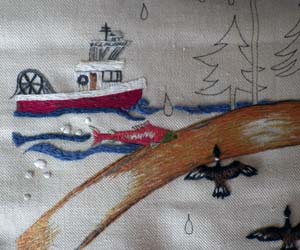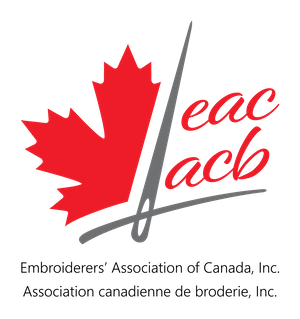
Address to Seminar 2017, St. John’s, NL – May 2017
Helen McCrindle: Project 150 Team Leader
In May of 2014 – three years ago, Seminar was held in Ottawa. Some members took a tour of Rideau Hall, home of the Governor-General of Canada. They were disappointed to discover that there was no textile art in the collection of Rideau Hall. The people on the bus tour had an idea to produce an embroidered piece of art to celebrate Canada’s upcoming sesquicentennial.
I was approached that summer by the then president, Beryl Burnett, to ask if I would become the team leader. I thought about it for a few days and took stock of the possible local textile artists that I could call on to be part of my team. I invited three people to be committed to the project. Catherine Nicholls, Bonnie Adie and Pat Ross met with me to brainstorm what would be included on our tribute to Canada.
These meetings were held frequently to nail down what we wanted and finally Catherine Nicholls, a textile artist from North Vancouver agreed to be the designer. She spent three long months on the design, which is divided into two panels because the woodwork on the walls in Rideau Hall is divided into 2-3 foot strips.
Once the design was completed in black and white, Catherine started the colouring of the images. Meanwhile, it was decided to use sturdy linen twill for the fabric as it is strong enough to receive all the different threads.
We decided on a mixture of DMC cotton floss for detail and Appleton Crewel wool.
There were many meetings with Catherine to determine the exact colours of both threads. In the end, there were 133 different colours of DMC cotton thread. DMC headquarters in the US agreed to donate two skeins of each thread. I supplied the Appleton wool threads of which there were 118 different colours. Metallic threads were also gathered for special effects.
We transferred the design to the cloth using Saral transfer paper. It is not permanent so we had to go over every line with archival pens to make the images permanent.
Once the design was on the fabric, we turned our attention to dividing up the design for embroidery. We divided each panel into a 6” square grid – 24 squares on each panel. We selected all the threads needed for each 6” square and stored the threads in small plastic bags.
All the while we were sampling many of the elements to see what the effects would be. Extensive directions were written for each of the squares.
Basic rules were established. No knots, two strands of cotton thread unless specified otherwise. One strand of crewel wool. Most important: Follow the coloured images.
The Western panel was started in Winnipeg and the Eastern panel in Truro, Nova Scotia. The panels were sent with their accompanying frames to the many guilds in the east and west and then at the end of 2015, the panels switched from east to west and west to east.
The panels have been worked on at festivals, like Folklorama in Winnipeg and in needlework store windows and even in grocery stores.
Our goal was to have the panels completed by December 2016, but that did not happen, so as of February of this year the panels have been in the Vancouver area and are currently in my studio where members of the
Vancouver Guild and the North Shore Needle Arts have been working on them.
Thousands of hours have been spent designing and writing directions and actually embroidering the designs. At each stop, the logbooks have been signed by our members with their comments.
Who knew that the mighty maple tree provided the wood for the early Lacrosse sticks? (Find it on the Eastern panel.)
Who can identify all of the provincial and territorial birds that are perched on the maple tree’s branches?
Who knew that the helicopters or seed pods of the maple tree are called ‘samaras’?
Did you discover that there are three golden ribbons that twist through both panels, representing the Trans Canada Highway, the Trans Canada Railway and the Trans Canada Trail?
Notice that there are bird and animal tracks that appear on the panels – moose tracks, Canada goose tracks, great blue heron tracks and polar bear tracks.
Did you know that the wispy bits at the tip of the wheat plant are called ‘awns’?
I have been struck by some of the comments in the logbooks, left by stitchers who have worked on the panels:
“We have enjoyed our time together, stitching on Project 150. It has brought our guild closer together. We are all looking forward to the unveil and seeing it hang in Ottawa.”
“Congratulations to our designer – what an epic way to represent Canada!”
“What a privilege to stitch on such a national project. It brings us all together.”
This comment was written on Remembrance Day. “It was poignant working on this today – what it means to be Canadian and to have the freedoms with our natural resources and our lives. Thank you for this opportunity.”
“Everyone who came to my house to stitch was apprehensive at first, but then enjoyed the process and were glad they had participated.”
“From coast to coast – people sharing a passion for the threaded needle!”
All the way along I have been in contact with the National Capital Commission who oversees the acquisitions of objects for the various venues in Ottawa. They wish to wait until the project is complete with cleaning, blocking, mounting, and photographing done until they will make a decision on the project. As of this time at Seminar in St. John’s, I estimate another 200 to 300 hours of embroidery left to complete the project.
I want to thank all members, young and not so young, who have spent some time translating the vision of the artist, Catherine Nicholls, into a Canadian tapestry of celebration!

Happy Birthday, Canada!
Update: May 2020
The past year brought about a sense of completion for this project that we started to celebrate and recognize Canada’s 150 anniversary as a country. All embroidery was finished by the end of 2018. The linen fabric was cleaned, stretched and framed in early 2019. In the fall of 2019, the Government of Canada arranged to ship the pieces to Ottawa where they were held until they were put in place.
The two Canadian Embroidery Tapestry panels were put on display just as the COVID-19 pandemic lockdown came into effect in March 2020. We will have a photographer take better photos of the panels on display as soon as it is safe and the residence is open to the public.
The embroidery has been assigned and hung in Rideau Hall in the Pauline Vanier room which is one of the most important interiors in Rideau Hall where a broad representation of furnishings and artwork from across the country can be appreciated.

Update: October 25, 2019
The two carefully packed panels were shipped to Ottawa on October 25, 2019. We are waiting to hear where they will be displayed and will let everyone know as soon as we do!
The project that we have called Project 150 for the past few years has a new name. In early May 2019, the project lead, Helen McCrindle, received word that the Canadian Embroidery Tapestry has been officially accepted into the Government of Canada’s Crown Collection.
More than 650 Canadians of all ages and origins stitched on the project and more than 8,000 hours of work were recorded.
You can read more in the July 6, 2019, article published by the North Shore News from Vancouver, BC.
A Project Update from Helen McCrindle
February 2016

One year ago my Vancouver team was putting together the many packages of threads and wools that would be needed to embroider the two panels of the project that will celebrate Canada’s entry into Confederation in 1867. Last May the Committee launched the project in Calgary at Seminar 2015 and ever since then, the two panels, one in the East and one in the West, have been circulating around the many guilds of our organization.
Hundreds of hours were spent designing, colouring, transferring the design and writing directions for the creation of this project.

The panels have gone through four seasons of the year. The summer was spent in Vancouver looking out over floral gardens, in the Maritimes looking out over seascapes. Fall brought stitchers on Vancouver Island and Eastern stitchers in Ontario. Winter came with a vengeance to the embroiderers in Ottawa and Quebec, and western stitchers in Alberta and Manitoba. Through it all, the panels have travelled in all weather conditions! The spring now entices the Fraser Valley embroiderers and Regina and Edmonton to put in their embroidery stitches in the West, and Montreal and St. John’s in the East.
Now, we look forward to Seminar 2016 in Toronto at Humber College, where the two embroidered panels will meet for the first time. Seminar participants will be able to spend time stitching on them. After Seminar the Eastern Panel will go West and the Western Panel will travel to the East of Canada.
I want to thank all members, young and not so young, who have spent some time translating the vision of the artist, Catherine Nicholls, into a tapestry of what it means to be Canada into stitch. May we continue throughout 2016 to complete the work. We hope to present the finished panels to the Government of Canada after our Seminar in 2017 in St. John’s, Newfoundland.
I look forward to the finished embroidery!

